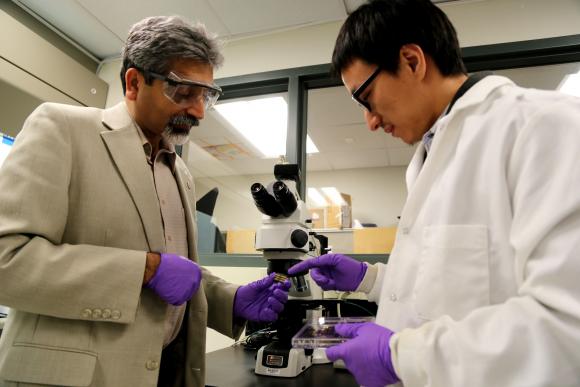
[Image above] Credit: Always Shooting; Flickr CC BY 2.0
The amount of solar energy radiating from the sun each day is tremendous. But because the sun’s energy is variable depending on the time of day or night, that energy needs to be captured and efficiently stored if it’s ever going to be our go-to energy source over the polluting fossil fuels we’re trying so desperately to leave in the dust.
And as commercialized solar energy solutions continue to trend upward, researchers have shifted focus on ways to scale up technology for the next solar frontier: solar fuels.
Earlier this month, researchers at Eindhoven University of Technology and the Foundation for Fundamental Research on Matter in the Netherlands developed a prototype of a solar cell that generates fuel instead of electricity.
The prototype processes gallium phosphide (GaP) into tiny nanowires, which enable the solar cell to separate hydrogen from liquid water to produce clean fuel in the form of hydrogen gas for use in the chemical industry or for combustion in fuel cells to drive engines—a very promising potential replacement for fossil and other polluting sources of fuel.
Recently, solar cells made from perovskites have been making news for their great potential for high efficiency and low cost—but more research needs to be done to scale up this technology for manufacturing use.
Enter: Brown University (Providence, R.I.). The university announced last week in a news release that “a new federal grant will support that effort and other perovskite improvements at Brown University, Rhode Island College, and the University of Nebraska-Lincoln.”
A team led by Brown University researchers has been awarded $4 million by the National Science Foundation to study this promising new type of solar cell.
“Perovskites have great promise for use in a variety of highly efficient, low-cost solar cells,” Nitin Padture, professor in the School of Engineering and director of Brown’s Institute for Molecular and Nanoscale Innovation, says in the news release. “We want to understand better the basic science behind these solar cells, look for ways to develop new technologies based on that understanding, and investigate scalable production methods that could one day bring perovskite solar cells to market.”

Nitin Padture, left, and engineering graduate student Yuanyuan Zhou examine solar cell film made from perovskite. Credit: Brown University
Perovskite solar cells came on the solar energy the scene in 2009, and they’re now “nearly as efficient as traditional silicon cells, but have the potential to be produced at a fraction of the cost,” according to the news release.
One of the main focuses of the project will be looking ways to scale up the production of perovskite films, “which raises their potential for use in building-integrated solar cells like shingles, siding, or even windows that can generate electricity,” according to the release. Padture and his team have already made progress in this area and plan to continue to make strides with this new grant.
“It’s an exciting technology, but there’s still much more work that needs to be done before perovskite solar cells are widely available,” Padture says.
For example, it’s not completely understood exactly by scientists how perovskite cells work at the molecular level. “Such understanding could help in improving efficiency of perovskite films and optimizing them for different applications,” according to the release.
What trends solar trends have you read about lately? Add to the discussion in the comments!
